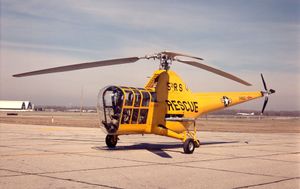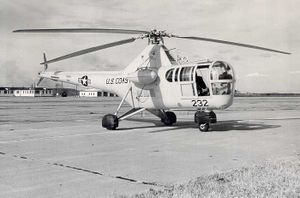PlaneSpottingWorld welcomes all new members! Please gives your ideas at the Terminal.
Sikorsky H-5

The Sikorsky H-5 (R-5 up to 1948), is a helicopter formerly used by the United States Air Force, and its predecessor, the United States Army Air Forces, as well as the United States Navy and United States Coast Guard (with the designations HO2S and HO3S). It was also used by the United States Post Office Department. [1]
The H-5 was designed to provide a helicopter having greater useful load, endurance, speed, and service ceiling than the Sikorsky R-4. The first XR-5 of four ordered made its initial flight on August 18, 1943. In March 1944, the United States Army Air Forces ordered 26 YR-5As for service testing, and in February 1945, the first YR-5A was delivered.
During its service life, the H-5 was used for rescue and mercy missions throughout the world. It gained its greatest fame, however, during the Korean War when it was called upon repeatedly to rescue United Nations' pilots shot down behind enemy lines and to evacuate wounded personnel from frontline areas before being replaced in most roles by the H-19 Chickasaw.
It was also manufactured under license in Britain by Westland as the Dragonfly I, all of which were powered by a 500hp Alvis Leonides engine.
More than 300 H-5s had been built by the time production was halted in 1951.
Contents
Designation
The R-5 was designated under the United States Army Air Force system, a series starting with R-1 and proceeded up to about R-16. In 1947 with the start of the United States Air Force, there was a new system, and many aircraft, but not all, were redesignated. The R-6 became the H-6. The United States Army broke off with its own designation system in the 1950s, resulting in new designations for its helicopter projects (such as HO-6). In 1962 under the new tri-service system (see 1962 United States Tri-Service aircraft designation system), many Navy and Army aircraft were given the low numbers. Under the 1962 system, the low H numbers were given to new aircraft. For example, H-6 was given to the HO-6, which entered service then as the OH-6.
Specifications
- Main rotor diameter: 48 ft (14.6 m)
- Tail rotor diameter: 8 ft 5 in (2.5 m)
- Fuselage Length: 41 ft 2 in (12.5 m)
- Height: 12 ft. 11 in. (3.9 m)
- Weight: 4,815 lb (2,184 kg) loaded
- Armament: None
- Engine: Pratt & Whitney R-985 of 450 hp (335.5 kW)
- Maximum speed: 90 mph (144.8 km/h)
- Cruising speed: 70 mph (112.6 km/h)
- Range: 280 miles (450.6 km)
- Service ceiling: 10,000 ft (3000 m)
H-5 Museum displays
Military Operators
Sikorsky S-51
Westland Dragonfly
- Template:BEL
- Template:EGY
- Template:FRA
- Template:ITA
- Template:SRI (Ceylon)
- Template:THA
- Template:UK: Royal Air Force, Royal Navy
- Template:YUG
See also
- Westland Widgeon - Westlands improved version
- Sikorsky R-4
External links
- Sikorsky H-5 page at the National Museum of the United States Air Force
- Sikorsky S-51 First Helicopter in Antarctica. Civil Aeronautics Direction page - Argentinian Government. Link in Spanish
- 1951 Popular Science article showing a Sikorsky S-51 delivering mail
Designation sequence
- Pre-1948 USAAC/F:
- Post-1948 USAF:
- 1922-1962 Navy :
Lists relating to aviation | |
|---|---|
| General | Timeline of aviation · Aircraft · Aircraft manufacturers · Aircraft engines · Aircraft engine manufacturers · Airports · Airlines |
| Military | Air forces · Aircraft weapons · Missiles · Unmanned aerial vehicles (UAVs) · Experimental aircraft |
| Notable incidents and accidents | Military aviation · Airliners · General aviation · Famous aviation-related deaths |
| Records | Flight airspeed record · Flight distance record · Flight altitude record · Flight endurance record · Most produced aircraft |
Lists relating to aviation | |
|---|---|
| General | Timeline of aviation · Aircraft · Aircraft manufacturers · Aircraft engines · Aircraft engine manufacturers · Airports · Airlines |
| Military | Air forces · Aircraft weapons · Missiles · Unmanned aerial vehicles (UAVs) · Experimental aircraft |
| Notable incidents and accidents | Military aviation · Airliners · General aviation · Famous aviation-related deaths |
| Records | Flight airspeed record · Flight distance record · Flight altitude record · Flight endurance record · Most produced aircraft |

